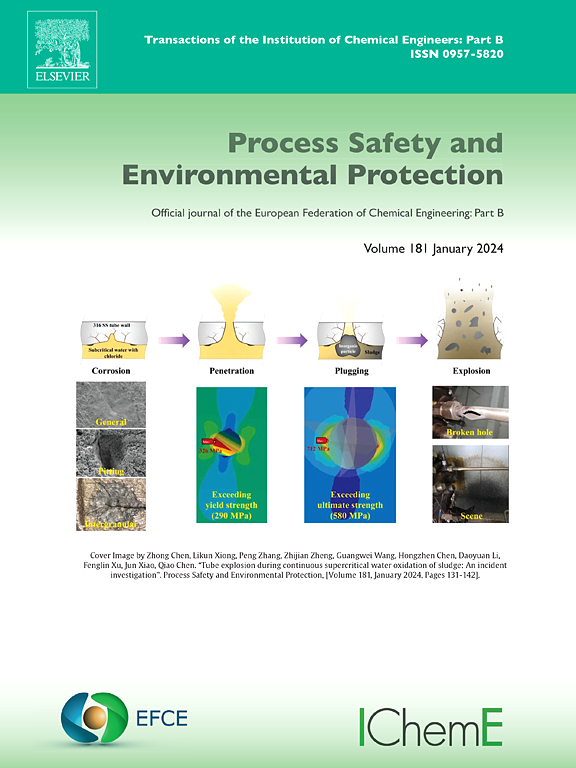Microwave-assisted hydrothermal carbonization of microalgae grown in swine wastewater: Process optimization and application of hydrochar for dye adsorption
IF 7.8
2区 环境科学与生态学
Q1 ENGINEERING, CHEMICAL
引用次数: 0
Abstract
This study presents an eco-friendly approach for converting microalgae cultivated in swine wastewater into value-added hydrochar via microwave-assisted hydrothermal carbonization (MHTC). Process parameters, including temperature, residence time, and biomass-to-water ratio, were optimized using response surface methodology (RSM) based on a Box–Behnken design. The optimal conditions—190 °C, 10 min, and a 7.5 % biomass-to-water ratio—resulted in a maximum hydrochar yield of 58.8 wt%. The resulting hydrochar exhibited a high carbon content (52.83 %) and a higher heating value (23.56 MJ/kg), with well-developed surface functionality and microporous structure, as confirmed by FTIR, SEM, and BET analyses. Its applicability as an adsorbent was demonstrated through batch adsorption experiments targeting methylene blue dye. The hydrochar achieved a maximum adsorption capacity of 107.5 mg/g with a removal efficiency of 87 %. Adsorption data fitted best with the Freundlich isotherm and pseudo-second-order kinetic models, indicating multilayer sorption on a heterogeneous surface. These findings highlight the dual environmental benefit of using swine wastewater as a nutrient source for microalgal cultivation and the subsequent valorization of biomass into functional hydrochar. This work contributes to advancing circular bioeconomy strategies by integrating waste treatment, carbon recovery, and low-cost dye remediation solutions.
猪废水中微藻的微波辅助水热碳化:工艺优化及氢炭吸附染料的应用
本研究提出了一种利用微波辅助水热碳化(MHTC)将猪废水中培养的微藻转化为增值碳氢化合物的环保方法。采用基于Box-Behnken设计的响应面法(RSM)优化工艺参数,包括温度、停留时间和生物质水比。最佳条件为190 °C, 10min,生物质水比为7.5%,最大烃类产量为58.8wt.%。FTIR、SEM和BET等分析结果表明,该产物碳含量高(52.83%),热值高(23.56 MJ/kg),具有良好的表面官能团和微孔结构。通过对亚甲基蓝染料的批量吸附实验,验证了其吸附剂的适用性。最大吸附量为107.5mg/g,去除率为87%。吸附数据最符合Freundlich等温线和拟二阶动力学模型,表明在非均质表面上有多层吸附。这些发现强调了利用猪废水作为微藻培养的营养来源和随后将生物质转化为功能碳氢化合物的双重环境效益。这项工作通过整合废物处理、碳回收和低成本染料修复解决方案,有助于推进循环生物经济战略。
本文章由计算机程序翻译,如有差异,请以英文原文为准。
求助全文
约1分钟内获得全文
求助全文
来源期刊

Process Safety and Environmental Protection
环境科学-工程:化工
CiteScore
11.40
自引率
15.40%
发文量
929
审稿时长
8.0 months
期刊介绍:
The Process Safety and Environmental Protection (PSEP) journal is a leading international publication that focuses on the publication of high-quality, original research papers in the field of engineering, specifically those related to the safety of industrial processes and environmental protection. The journal encourages submissions that present new developments in safety and environmental aspects, particularly those that show how research findings can be applied in process engineering design and practice.
PSEP is particularly interested in research that brings fresh perspectives to established engineering principles, identifies unsolved problems, or suggests directions for future research. The journal also values contributions that push the boundaries of traditional engineering and welcomes multidisciplinary papers.
PSEP's articles are abstracted and indexed by a range of databases and services, which helps to ensure that the journal's research is accessible and recognized in the academic and professional communities. These databases include ANTE, Chemical Abstracts, Chemical Hazards in Industry, Current Contents, Elsevier Engineering Information database, Pascal Francis, Web of Science, Scopus, Engineering Information Database EnCompass LIT (Elsevier), and INSPEC. This wide coverage facilitates the dissemination of the journal's content to a global audience interested in process safety and environmental engineering.
 求助内容:
求助内容: 应助结果提醒方式:
应助结果提醒方式:


